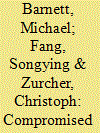| Srl | Item |
| 1 |
ID:
134525


|
|
|
|
|
| Summary/Abstract |
There is considerable evidence that peacebuilding operations are more likely to reproduce important elements of the status quo than they are to propel post-conflict states toward a liberal democracy. In contrast to existing theories that focus on the resources available to peacebuilders or the degree of damage caused by the war to explain the outcome, we highlight the interaction between international and domestic actors. Specifically, we conceive of peacebuilding as a strategic process involving peacebuilders, a postwar government, and other local elites. The equilibrium results show that this process typically concludes in a compromised peacebuilding outcome. This is not surprising when the policy preferences of the actors diverge, but the results also hold when domestic elites prefer a liberal democracy to the status quo. Why? Primarily, because postwar governments are rewarded by relatively impatient peacebuilders with more resources than they would otherwise receive. Additionally, if there exists a secondary elite with veto power, a compromised outcome becomes even more likely. We illustrate these findings with reference to post-1989 peacebuilding operations. Although peacebuilding might not work as it is intended, in the conclusion, we argue that it is better than the alternatives and propose a more realistic measure of peacebuilding success.
|
|
|
|
|
|
|
|
|
|
|
|
|
|
|
|
| 2 |
ID:
119717


|
|
|
|
|
| Publication |
2013.
|
| Summary/Abstract |
Local communities such as villages are commonly assumed to be vital partners in counterinsurgency and post-conflict reconstruction. However, the success of all policies based on this assumption depends on the level of social cohesion at the community level: communities with internal cleavages and fissures will be less effective in making external efforts a success. In this article, we study how exposure to violence during civil war affects the internal cohesion of a community. On the one hand, we could assume that exposure to a common threat strengthens social ties. On the other hand, shifting power structures in conflict regions could introduce new loyalties and cleavages at the village level, thus eroding a community's social glue. We use data from a survey conducted in northern Afghanistan and combine it with the data on violent events from military records. Our results provide evidence for the second mechanism: exposure to violence causes villagers to diverge in their support for conflicting parties. We estimate a spatial-temporal gravity model, where spatially and temporally proximate events have the highest impact on this divergence at the village level.
|
|
|
|
|
|
|
|
|
|
|
|
|
|
|
|